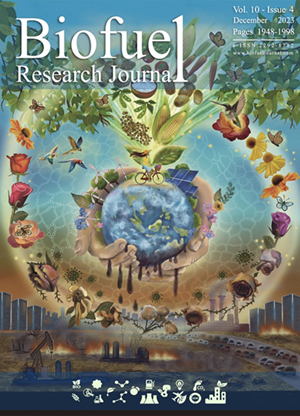多相催化剂在麻疯树油制备生物柴油中的定性作用
IF 11.9
Q1 ENERGY & FUELS
引用次数: 30
摘要
生物柴油的特性通常归因于所使用的油原料的组成和特性,忽略了催化剂制备细节可能产生的影响。鉴于此,研究了不同的催化剂制备技术以及不同的载体材料对由相同的石油原料生产的生物柴油的产率、组成和燃料性能的影响。具体而言,以氧化镁或氧化锌为载体材料,通过两种不同的工艺(绿色合成和湿浸渍)合成了三金属(Fe-Co-Ni)催化剂。采用湿浸渍法制备Fe-Co-Ni/MgO和Fe-Co-Ni/ZnO催化剂对,绿色合成(叶提取物)法制备Fe-Co-Ni-MgO和Fe-Co-Ni-ZnO催化剂对,用于麻疯树油的酯交换反应。对催化剂进行了详细的形态、组成、热稳定性、结晶性质和官能团表征。采用Box-Behnken设计响应面法,发现绿色合成的Fe-Co-Ni-MgO催化剂的生物柴油产率最高,达到97.9%。更重要的是,在使用相同原料的情况下,四种催化剂制备的生物柴油的脂肪酸甲酯(FAME)谱以及各自的燃料性能存在差异。本文章由计算机程序翻译,如有差异,请以英文原文为准。
Qualitative role of heterogeneous catalysts in biodiesel production from Jatropha curcas oil
Biodiesel properties are in general attributed to the composition and properties of the oil feedstock used, overlooking the possible impacts of the catalyst preparation details. In light of that, the impacts of different catalyst preparation techniques alongside those of different support materials on the yield, composition, and fuel properties of biodiesels produced from the same oil feedstock were investigated. More specifically, tri-metallic (Fe-Co-Ni) catalyst was synthesized through two different techniques (green synthesis and wet impregnation) using MgO or ZnO as support material. The generated catalyst pairs, i.e., Fe-Co-Ni/MgO and Fe-Co-Ni/ZnO prepared by wet impregnation and Fe-Co-Ni-MgO and Fe-Co-Ni-ZnO prepared by green synthesis (using leaf extracts) were used in the transesterification process of Jatropha curcas oil. Detailed morphological properties, composition, thermal stability, crystalline nature, and functional groups characterization of the catalysts were also carried out. Using Box-Behnken Design response surface methodology, it was found that the green-synthesized Fe-Co-Ni-MgO catalyst resulted in the highest biodiesel yield of 97.9%. More importantly, the fatty acid methyl ester (FAME) profiles of the biodiesels produced using the four catalysts as well as their respective fuel properties were different in spite of using the same oil feedstock.
求助全文
通过发布文献求助,成功后即可免费获取论文全文。
去求助
来源期刊

Biofuel Research Journal-BRJ
ENERGY & FUELS-
CiteScore
22.10
自引率
1.50%
发文量
15
审稿时长
8 weeks
期刊介绍:
Biofuel Research Journal (BRJ) is a leading, peer-reviewed academic journal that focuses on high-quality research in the field of biofuels, bioproducts, and biomass-derived materials and technologies. The journal's primary goal is to contribute to the advancement of knowledge and understanding in the areas of sustainable energy solutions, environmental protection, and the circular economy. BRJ accepts various types of articles, including original research papers, review papers, case studies, short communications, and hypotheses. The specific areas covered by the journal include Biofuels and Bioproducts, Biomass Valorization, Biomass-Derived Materials for Energy and Storage Systems, Techno-Economic and Environmental Assessments, Climate Change and Sustainability, and Biofuels and Bioproducts in Circular Economy, among others. BRJ actively encourages interdisciplinary collaborations among researchers, engineers, scientists, policymakers, and industry experts to facilitate the adoption of sustainable energy solutions and promote a greener future. The journal maintains rigorous standards of peer review and editorial integrity to ensure that only impactful and high-quality research is published. Currently, BRJ is indexed by several prominent databases such as Web of Science, CAS Databases, Directory of Open Access Journals, Scimago Journal Rank, Scopus, Google Scholar, Elektronische Zeitschriftenbibliothek EZB, et al.
 求助内容:
求助内容: 应助结果提醒方式:
应助结果提醒方式:


